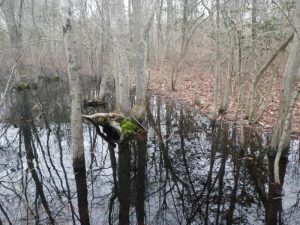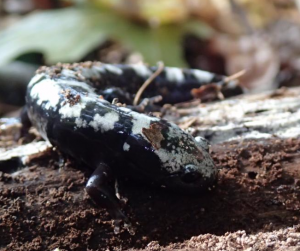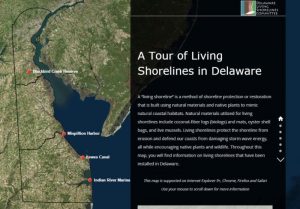
Facebook Twitter Instagram YouTube RSS Feed
Written on: December 19th, 2015 in Outreach

Freshwater Wetland
Coastal Plain Seasonal Ponds, also called Delmarva Bays, are small, shallow, seasonally-wet areas. They are fed by groundwater, rain or snow and usually fill up in winter and spring and dry out in summer and fall. Often surrounded by woodlands, the inner (wetter) zones feature a variety of low shrubs (e.g. buttonbush and blueberry) and grassy plants.
Coastal Plain Seasonal Ponds are gems across the Delmarva landscape because of their unique geologic formation, water level fluctuations, and special plant and animal communities. Although regionally these special wetlands occur from Massachusetts to Florida, they are rare in Delaware and make up only about 2% of the state’s total wetland acreage. Delaware has several hundred small Coastal Plain Seasonal Ponds which are concentrated in inland parts of lower New Castle and upper/middle Kent counties (Blackbird area).
Coastal Plain Seasonal Ponds provide critical habitat to many state and globally rare or threatened animals (such as the marbled salamander and carpenter frog) and plants (such as Hirst Brothers’ panic grass and featherfoil). They support 50 plant species considered rare or uncommon in the state, and nine plant species which are classified as rare in the world. These wetlands are especially vital to amphibians for breeding and survival. Frogs and salamanders use the temporary ponds to find mates and lay egg clusters – and can only do so because predatory fish cannot survive in the temporary ponded water. In the summer they use the surrounding drier forested wetlands and uplands as summer habitat, hiding under moist fallen leaves and logs to stay cool.

Marbled Salamander (WMAP)
Many of these habitats have been already lost, and those remaining are vulnerable to degradation or loss. Coastal Plain Seasonal Ponds are not connected to streams or other waterways and are isolated on the landscape. This detail prevents them from being regulated by either the federal or state government and makes them more vulnerable to harmful wetland impacts such as filling or draining. Preservation of these wetlands, and of adjacent contiguous forested habitat, is a high conservation priority. Voluntary conservation and vegetated buffers are prime ways to care for these unique features. For more information contact Mark.Biddle@delaware.gov or call 302-739-9939.
Written on: December 11th, 2015 in Living Shorelines
 Get an up-close and personal tour of living shoreline projects across the State of Delaware from the comfort of your own home:de.gov/livingshorelinesites. This modern interface will give you a quick summary of various tidal wetland living shoreline installations, and includes specific goals, materials used, time series photos and the project point of contact.
Get an up-close and personal tour of living shoreline projects across the State of Delaware from the comfort of your own home:de.gov/livingshorelinesites. This modern interface will give you a quick summary of various tidal wetland living shoreline installations, and includes specific goals, materials used, time series photos and the project point of contact.
Quick links are also provided for more information pertaining to permitting, material suppliers, best practices and more. Know of a living shoreline project in Delaware and want it included in this tour? Please contact Alison.Rogerson@delaware.gov or call 302-739-9939.
The Tour of Living Shorelines in Delaware was brought to you by the Delaware Living Shorelines Committee, a work group dedicated to the facilitation of understanding, promoting and implementing living shoreline tactics within the State of Delaware.